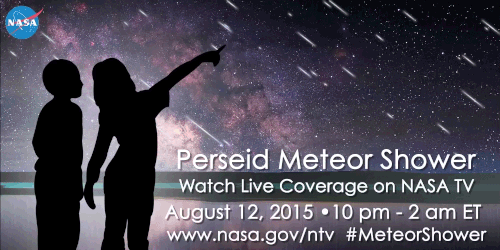What Are Perseid Meteors, And Why Should You Be Excited For Them This Year? Let Us Tell You!

What are Perseid Meteors, and why should you be excited for them this year? Let us tell you!
The Perseid meteor shower is caused by debris from Comet Swift-Tuttle as it swings through the inner solar system and ejects a trail of dust and gravel along its orbit. When the Earth passes through the debris, specs of comet-stuff hit the atmosphere at 140,000 mph and disintegrate in flashes of light. Meteors from this comet are called Perseids because they seem to fly out of the constellation Perseus.

Last year, this meteor shower peaked during a bright “supermoon”, so visibility was reduced. Luckily, forecasters say the show could be especially awesome this year because the Moon is nearly new when the shower peaks on Aug. 12-13.
The best place to view the event is away from city lights around midnight. Under a clear, dark sky forecasters predict meteor rates as high as 100 per hour on peak night. So, get outside, look up and enjoy the show!
If your area has poor visibility on the peak night, we’ve got you covered! We’ll be hosting a live broadcast about the meteor shower from 10 p.m. EDT Wednesday, Aug. 12, to 2 a.m. Thursday, Aug. 13. In addition to footage from our live skycam, the program will highlight the science behind the Perseids, as well as our research related to meteors and comets. Tune in on NASA TV or our UStream Channel.
More Posts from Paradoxfox-blog and Others

Video Games by Sevech

when I am with you… by coffaefox

RT @TheKamillex: #FursuitFriday 🐶🐶🐶🐶🐶🐶 http://t.co/nwJZC9Ju1q (Source)


Light of my Heart by demicoeur

Disney Zootopia poster

Tomorrow at 5ET I’ll be interviewing three astronauts (read all about them here) live on Periscope and Snapchat (user: nprnews).
What would you like me to ask them? Submit questions here.




Cosmosepticeye and Wandaplier

rain by Orphen-Sirius

Playstation Pups by Tim Weeks
-
 sweetbutterbliss liked this · 3 years ago
sweetbutterbliss liked this · 3 years ago -
 star-light-on-a-shoe-string-blog liked this · 7 years ago
star-light-on-a-shoe-string-blog liked this · 7 years ago -
 myheartwokemecryinglastnight liked this · 8 years ago
myheartwokemecryinglastnight liked this · 8 years ago -
 shelbytimesadness reblogged this · 8 years ago
shelbytimesadness reblogged this · 8 years ago -
 shuflypie reblogged this · 8 years ago
shuflypie reblogged this · 8 years ago -
 drrrling liked this · 8 years ago
drrrling liked this · 8 years ago -
 definitely-not-a-werewolf reblogged this · 8 years ago
definitely-not-a-werewolf reblogged this · 8 years ago -
 themiseight liked this · 8 years ago
themiseight liked this · 8 years ago -
 serafinasalomea reblogged this · 8 years ago
serafinasalomea reblogged this · 8 years ago -
 triangle-worshiper-blog reblogged this · 8 years ago
triangle-worshiper-blog reblogged this · 8 years ago -
 triangle-worshiper-blog liked this · 8 years ago
triangle-worshiper-blog liked this · 8 years ago -
 annartgraphie liked this · 8 years ago
annartgraphie liked this · 8 years ago -
 easterneuropeanprincess reblogged this · 8 years ago
easterneuropeanprincess reblogged this · 8 years ago -
 keepitaurea liked this · 8 years ago
keepitaurea liked this · 8 years ago -
 loqmedalagana liked this · 8 years ago
loqmedalagana liked this · 8 years ago -
 smg1ne liked this · 8 years ago
smg1ne liked this · 8 years ago -
 kali-ka liked this · 9 years ago
kali-ka liked this · 9 years ago -
 carmillasworld liked this · 9 years ago
carmillasworld liked this · 9 years ago -
 cheezewizardsstuff liked this · 9 years ago
cheezewizardsstuff liked this · 9 years ago -
 tinkerbell922 liked this · 9 years ago
tinkerbell922 liked this · 9 years ago -
 numberoneave-blog liked this · 9 years ago
numberoneave-blog liked this · 9 years ago -
 falkenschwinge liked this · 9 years ago
falkenschwinge liked this · 9 years ago -
 gallifreanpotterhead liked this · 9 years ago
gallifreanpotterhead liked this · 9 years ago -
 space-hoe reblogged this · 9 years ago
space-hoe reblogged this · 9 years ago -
 jazracanah liked this · 9 years ago
jazracanah liked this · 9 years ago -
 seebbs730 liked this · 9 years ago
seebbs730 liked this · 9 years ago -
 brittanyalexiswilliamsx liked this · 9 years ago
brittanyalexiswilliamsx liked this · 9 years ago -
 first-class-cutie liked this · 9 years ago
first-class-cutie liked this · 9 years ago -
 zay-savage-flex-blog liked this · 9 years ago
zay-savage-flex-blog liked this · 9 years ago -
 auxrane liked this · 9 years ago
auxrane liked this · 9 years ago -
 methyou-ten liked this · 9 years ago
methyou-ten liked this · 9 years ago -
 andreluizlinosilva-blog liked this · 9 years ago
andreluizlinosilva-blog liked this · 9 years ago -
 hystericheavy liked this · 9 years ago
hystericheavy liked this · 9 years ago
Hello! I'm paradox the blue fox. I'm a gay furry. Love doctor who. I'm a musician, wheel throwing artist, and a glassblowing artist. I love space.
190 posts